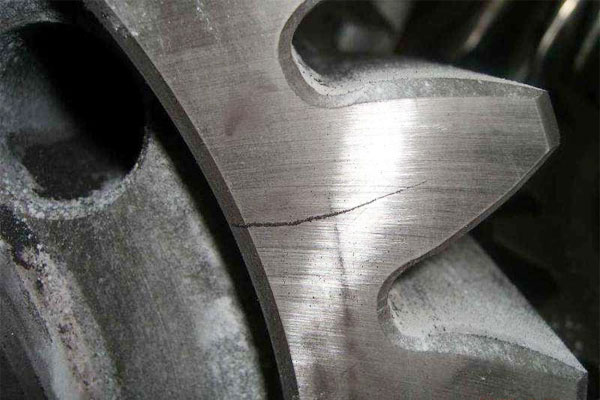In large forging, when the quality of raw materials is poor or forging process is not at the right time, forging cracks are often easy to occur.
The following introduces several cases of forging crack caused by poor material.
(1) Forging cracks caused by ingot defects
Most of the ingot defects may cause cracking during forging, as shown in Picture , which is the central crack of 2Cr13 spindle forging.
This is because the crystallization temperature range is narrow and the linear shrinkage coefficient is large when the 6T ingot solidifies.
Due to insufficient condensation and shrinkage, large temperature difference between inside and outside, large axial tensile stress, the dendrite cracked, forming an inter-axial crack in the ingot, which was further expanded during forging to become a crack in the spindle forging.
The defect can be eliminated by:
(1)To improve the purity of molten steel smelting;
(2) Ingot cooling slowly, reducing thermal stress;
(3) Use good heating agent and insulation cap, increase the ability of filling shrinkage;
(4)Use the center compaction forging process.
(2) Forging cracks caused by the precipitation of harmful impurities in steel along grain boundaries.
The sulfur in steel is often precipitated along the grain boundary in the form of FeS, whose melting point is only 982℃. At the forging temperature of 1200℃, THE FeS on the grain boundary will melt and surround the grains in the form of liquid film, which will destroy the bond between the grains and produce thermal fragility, and the cracking will occur after slight forging.
When copper contained in steel is heated in a peroxidation atmosphere at 1100 ~ 1200℃, due to selective oxidation, copper-rich areas will form on the surface layer. When the solubility of copper in austenite exceeds that of copper, copper is distributed in the form of liquid film at grain boundary, forming copper brittleness and unable to be forged.
If there are tin and antimony in steel, the solubility of copper in austenite will be reduced seriously, and the embrittlement tendency will be intensified.
Due to the high copper content, the surface of steel forgings is selectively oxidized during forging heating, so that the copper is enriched along the grain boundary, and the forging crack is formed by nucleating and expanding along the copper-rich phase of grain boundary.
(3) Forging crack caused by heterogeneous phase (second phase)
The mechanical properties of the second phase in steel are often very different from that of the metal matrix, so the additional stress will cause the overall process plasticity to decrease when the deformation flows. Once the local stress exceeds the binding force between the heterogeneous phase and the matrix, the separation will occur and the holes will be formed.
For example, the oxides, nitrides, carbides, borides, sulfides, silicates and so on in steel.
Let's say these phases are dense.
Chain distribution, especially along the grain boundary where the weak binding force exists, high temperature forging will crack.
The macroscopic morphology of forging cracking caused by fine AlN precipitation along grain boundary of 20SiMn steel 87t ingots has been oxidized and presented as polyhedral columnar crystals.
The microscopic analysis shows that the forging cracking is related to the large amount of fine grain AlN precipitation along the primary grain boundary.
The countermeasures to prevent forging cracking caused by precipitation of aluminum nitride along crystal are as follows:
1. Limit the amount of aluminum added to steel, remove nitrogen from steel or inhibit AlN precipitation by adding titanium;
2. Adopt hot delivery ingot and supercooled phase change treatment process;
3. Increase the heat feeding temperature (> 900℃) and directly heat forging;
4. Before forging, sufficient homogenization annealing is carried out to make grain boundary precipitation phase diffusion.
Post time: Dec-03-2020

